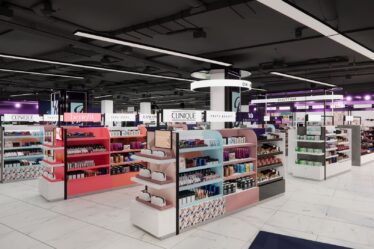
For online retailers, beauty has become a losing game.
As the beauty industry grew both in value and number of super users, fashion e-tailers rushed to add skincare, cosmetics and fragrances to their assortments, jostling against pure players for more market share. But now, many seem to have bitten off more than they chew.
“Digital commerce is much less profitable than people originally expected it to be five years ago,” said Benjamin Bond, vice president of strategy and business development at store intelligence platform Simbe. (At time of interview, Bond was a principal in the consumer practice of the strategy firm Kearney.)
A general softening in the luxury market has seen many multi-brand e-tailers lose their footing, as a combination of rocketing prices and uncertain economic climates made consumers more bearish. Top executive reshuffles further destabilised internal operations.
Net-A-Porter has cut down its selection from over 200 beauty brands in 2022 to just over 70 today, with a further slimming down expected for brands – many of the lines already removed from the site were generating less than $150,000 a year in sales, according to emails seen by The Business of Beauty. The company did not respond to a request for comment. Farfetch, in turn, amid a string of wider financial woes, shuttered in-house beauty in 2023 after only a little more than a year in operation, while the upmarket London retailer Browns, which it bought in 2015, closed beauty too.
But even beauty pure players are feeling the pinch.
The beauty arm of UK-based THG, which owns the e-tailers Look Fantastic, Cult Beauty and Dermstore as well as brands such as Perricone MD, is in similar shape: its average order value and number of orders are essentially flat since 2021, and it lost 700,000 active customers in 2023. Despite a 2.6 percent uplift in the final quarter of the year, revenue for the division declined 4.2 percent to £1.2 billion ($1.4 billion) in 2023.
And with Dermstore’s sales at roughly $194 million and Cult Beauty’s $170 million when it purchased them in 2021, sales for both companies have fallen since THG’s acquisition. Representatives for the brand declined to comment, though division chief executive Lucy Gorman has previously told press she expects a return to growth in 2024.
For UK-based Beauty Bay, which stocks the likes of E.l.f Beauty, Sol de Janiero and The Inkey List, 2023 sales were down 19 percent to $94 million, following another 31 percent decline in the previous year, according to public filings. Beauty Bay did not respond to requests for comment.
“When you look at [companies] that launched 10 years ago, they really had a lead in terms of digital experience. That lead is shrinking,” said Joël Palix, founder of beauty consultancy Palix Unlimited and former chief executive of e-tailer Feelunique.
And as individual beauty brands increasingly build out capabilities on their own DTC sites – including AI-powered recommendations and virtual try-on – they’re often furthering competition with the retailers that carry them. Oftentimes, these partners and beauty labels are competing for the same customer, with the same assortment of brands.
To beat the odds, e-tailers need to either offer a truly unique proposition, or consider a more phygital approach. “If you want to sell beauty online, you need to offer samples, you need to do events, you need to create content … you must make the consumer experience unique,” said Palix.
The Race to The Bottom
In-store, a shopper is unlikely to visit multiple retailers in a single day looking for the best price on a lipstick; however online, all of those prices are displayed for comparison in front of them. Online retailers are then forced into a near-constant battle of promotions, with each online store discounting further to convince consumers to shop with their outlet.
“[It’s harder to] build a full-price customer relationship online,” said Oliver Garfield, chief executive of premium beauty retailer Cos Bar, which operates 21 locations across the US as well as an e-commerce site.
E-tailers are also exposed to other fluctuations. While brick-and-mortar stores’ primary costs – like rent and payroll – are essentially fixed costs, e-commerce has more variable costs, like merchant services and advertising, said Garfield.
“People love e-commerce because you don’t have to dump in a ton of working capital and have lease liabilities,” he said. But these variable expenses can eat into a retailer’s per-dollar margin, without the promise of an increased order value.
Customers shopping for cosmetics, skincare or fragrance also often elude rudimentary forms of customer profiling, making it harder for retailers to actually know them, said Palix. “Beauty shoppers are very agnostic in terms of price, and depending on their mood, also the category,” he said, adding that a shopper who splurges on handbags might scrimp more when it comes to beauty, or vice versa. Pure players might be less affected by this, but for fashion retailers, accurate forecasting is more complex.
Standing Out From the Crowd
In order to get ahead from the pack, retailers need to offer a clear point of differentiation. They also need to be seen as a beauty authority, and a space for discovery. This is harder as influencers have become storefronts in their own right, said Bond.
One way e-tailers have tried to regain their cool is through stocking exclusive brands. Becoming the only retailer who can offer a hot new brand will bring consumers to your website, but when that window expires, so can your appeal.
While endeavours to enhance the customer experience can be costly and complex to onboard for multiple brands, online retailers shouldn’t make them an automatic write-off. Adding functions like virtual try-on or concierge support to help customers shade-match with confidence can increase conversion. A content vertical with blog posts and articles can build out a brand universe. Sophisticated sampling services, competitive loyalty programmes and personable, customer-service clienteling can also go a long way. Bond advised “getting creative” with influencer or partnership programmes to inspire customers, as well as ensuring a consistent, intuitive user interface with room for personalisation. That personalisation can include product suggestions based on past orders, top-up reminders or targeted offers.
Any investments must be weighed carefully, though. “If you want to have more differentiation [in beauty e-tail], you have to spend a lot, and there’s a pretty good chance that you might not get a lot of credit for it,” said Bond. Competitors can easily replicate many of these efforts, and extra enticements like same- or next-day shipping can rapidly add up. “It’s a huge amount of margin to execute that last mile delivery.”
Room to Grow
There are bright spots for digital beauty commerce – namely, in regions not inundated with beauty stores already. Pure player Notino, headquartered in the Czech Republic, raised €280 million ($302 million) in August 2023 for its expansion into new territories like Serbia, Norway and Turkey.
Gross merchandise value at Nykaa, Indian’s beauty-led juggernaut grew 29 percent to 36.19 billion rupees ($433 million) in its third-quarter earnings announced in February. Challenger retailer Tira clocked up 1.5 million downloads of its app in the first few months of its 2023 launch, and has since expanded into physical stores.
And in China, digital shopping platforms like Tmall and Pinduoduo remain the default for many consumers.
In the Western world, however, distribution is saturated, and competition is intense, with many institutions like Sephora having had decades to build customer loyalty, said Palix.
That’s not to say there’s no place for beauty e-commerce. “Omnichannel” is the word on everyone’s lips, as customers – and investors – alike favour a mix of physical and digital retail spaces, and buy online, pick up in store (BOPIS) services generate traffic both online and offline.
An omnichannel strategy takes careful calibration, however. The relationship between the digital and bricks-and-mortar businesses of a company can become fractious if perennial online promotions and incentives thin the appeal of shopping in-store. Garfield recalled a conversation with a recent hire who had joined the company from Nordstrom: “I asked him, ‘Who was your biggest competitor there?’, and he said, ‘Nordstrom.com.’”



